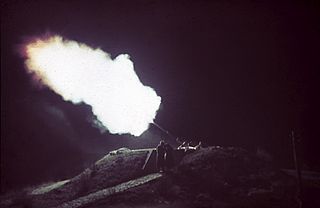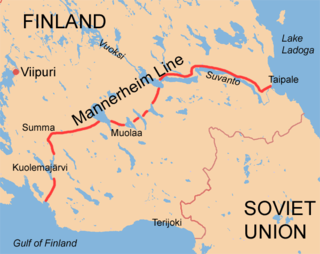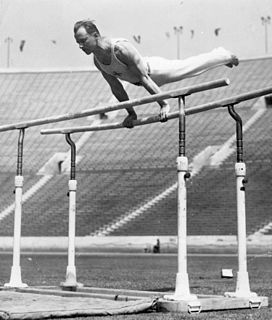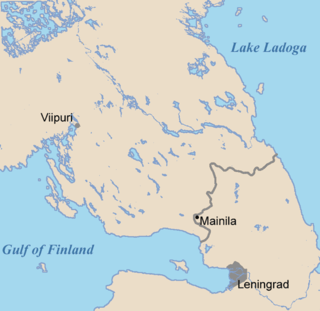 W
WThe Winter War was a war between the Soviet Union (USSR) and Finland. It began with a Soviet invasion of Finland on 30 November 1939, three months after the outbreak of World War II, and ended three and a half months later with the Moscow Peace Treaty on 13 March 1940. Despite superior military strength, especially in tanks and aircraft, the Soviet Union suffered severe losses and initially made little headway. The League of Nations deemed the attack illegal and expelled the Soviet Union from the organisation.
 W
WThe capital of Finland, Helsinki was bombed repeatedly during World War II. Between 1939–1944 Finland was subjected to a number of bombing campaigns by the Soviet Union. The largest raids were three raids in February 1944, which have been called The Great Raids Against Helsinki.
 W
WThe Cross of Sorrow is a memorial in Russia dedicated to the thousands of soldiers of both sides who perished in the Winter War of 1939–1940 when the Soviet Union attacked Finland. It is located in Pitkyarantsky District, Karelia, near the crossroads Pitkyaranta – Suojarvi / Petrozavodsk – Vyartsilya, 19 km off Pitkyaranta. It is the first monument to the Winter War in Russia.
 W
WJuho Eljas Erkko was a Finnish politician and journalist. He was a foreign minister and negotiated with the Soviet Union before the Winter War started. Erkko's father was politician and journalist Eero Erkko and son journalist Aatos Erkko.
 W
WAs a result of the 1940 Moscow Peace Treaty that concluded the Winter War, Finland ceded the area of Finnish Karelia and other territories to the Soviet Union. As a result, about 410,000 Finnish Karelians, or 12% of Finland's population, were relocated to the remainder of Finland.
 W
WThe Finnish Democratic Republic, also known as the Terijoki Government, was a short-lived puppet state of the Soviet Union in Finland from December 1939 to March 1940.
 W
WThe Finnish Relief Fund was a humanitarian aid organization initiated by former U.S. President Herbert Hoover in December 1939. It was intended to support Finnish civilians during the Winter War. By March 1940, it had raised 2.5 million US dollars.
 W
WDuring World War II some 70,000 Finnish children were evacuated from Finland, chiefly to Sweden, but also to Norway and Denmark. Most were evacuated during the Continuation War (1941-1944) to ease the situation for their parents who set out to rebuild their homes in the re-conquered Karelia returning from the 1940 evacuation of Finnish Karelia. The first surge of evacuees arrived, however, during the Winter War when the Finns had reasons to fear a humanitarian catastrophe following the expected Soviet occupation.
 W
WFinnish–Estonian defence co-operation began in 1930 with a secret military pact between Finland and Estonia against the threat of the Soviet Union. Open co-operation ended in 1939, as the Soviets pressured the Estonian government, but it continued secretly with information-sharing during the Winter War.
 W
WDuring the early stages of World War II, the British and French Allies made a series of proposals to send troops to assist Finland against the Soviet Union in the Winter War, which started on 30 November 1939. The plans involved the transit of British and French troops and equipment through neutral Norway and Sweden. The initial plans were abandoned due to Norway and Sweden declining transit through their land, fearing their countries would be drawn into the war. The Moscow Peace Treaty ended the war in March 1940, precluding the possibility of intervention.
 W
WHanko Naval Base was a Soviet naval base from 1940 to 1941 in the town of Hanko at the Hankoniemi peninsula which is located 100 kilometers (62 mi) from Helsinki, the Finnish capital.
 W
WSimo "Simuna" Häyhä was a Finnish military sniper. He used a Finnish-produced M/28-30 rifle, a variant of the Mosin–Nagant rifle, and a Suomi KP/-31 submachine gun. Häyhä is believed to have killed over 500 men during the 1939–40 Winter War, the highest number of sniper kills in any major war.
 W
WKarelia is a historical province of Finland which Finland partly ceded to Russia after the Winter War of 1939–40. The Finnish Karelians include the present-day inhabitants of North and South Karelia and the still-surviving evacuees from the ceded territories. Present-day Finnish Karelia has 315,000 inhabitants. The more than 400,000 evacuees from the ceded territories re-settled in various parts of Finland.
 W
WThe Karelo-Finnish Soviet Socialist Republic, also called Soviet Karelia or simply known as Karelia, was a republic of the Soviet Union. It existed from 1940 until it was made part of the Russian SFSR in 1956 as the Karelian Autonomous Soviet Socialist Republic. The latter became the Republic of Karelia, a federal subject of Russia, on 13 November 1991.
 W
WErnst Ruben Lagus was a Finnish Major General.
 W
WLotta Svärd was a Finnish voluntary auxiliary paramilitary organisation for women. Formed originally in 1918, it had a large membership undertaking volunteer social work in the 1920s and 1930s. It was formed to support the White Guard. During the Second World War, it mobilized to replace men conscripted into the army. It served in hospitals, at air raid warning positions, and other auxiliary tasks in close cooperation with the army. The women were officially unarmed except for an antiaircraft battery in 1944. Virtanen argues that, their "accountability to the nation took a masculine and military form in public, but had a private, feminine side to it including features like caring, helping and loving." The organisation was suppressed by the government after the war.
 W
WThe Mannerheim Line was a defensive fortification line on the Karelian Isthmus built by Finland against the Soviet Union. During the Winter War it became known as the Mannerheim Line, after Field Marshal Baron Carl Gustaf Emil Mannerheim. The line was constructed in two phases: 1920–1924 and 1932–1939. By November 1939, when the Winter War began, the line was by no means complete.
 W
WThe Molotov–Ribbentrop Pact was a non-aggression pact between Nazi Germany and the Soviet Union that enabled those two powers to partition Poland between them. The pact was signed in Moscow on 23 August 1939 by German Foreign Minister Joachim von Ribbentrop and Soviet Foreign Minister Vyacheslav Molotov and was officially known as the Treaty of Non-Aggression between Germany and the Union of Soviet Socialist Republics.
 W
WThe Moscow Peace Treaty was signed by Finland and the Soviet Union on 12 March 1940, and the ratifications were exchanged on 21 March. It marked the end of the 105-day Winter War, upon which Finland ceded border areas to the Soviet Union. The treaty was signed by Vyacheslav Molotov, Andrey Zhdanov and Aleksandr Vasilevsky for the Soviet Union, and Risto Ryti, Juho Kusti Paasikivi, Rudolf Walden and Väinö Voionmaa for Finland. The terms of the treaty were not reversed after the dissolution of the Soviet Union, and the Karelian question remains disputed.
 W
WBoris Arkadyevich Rybkin – born Boruch Aronovich Rivkin Russian: Борух Аронович Рывкин; 19 June 1899 – 27 November 1947) was a Soviet diplomat and a secret agent of NKVD. He worked as a junior diplomatic official named Boris Yartsev in the embassy of the Soviet Union in Helsinki.
 W
WThe Salpa Line, or its official name, Suomen Salpa, is a bunker line on the eastern border of Finland. It was built during the Interim Peace between the Winter War and the Continuation War to defend Finland against a possible Soviet invasion.
 W
WHeikki Ilmari Savolainen was a Finnish artistic gymnast. He competed in five consecutive Olympics from 1928 to 1952 and won at least one medal in each of them. In 1928, he won a bronze on pommel horse, which was the first-ever medal in gymnastics for Finland. Winning his last medal at the 1952 Summer Olympics in Helsinki, he became the oldest gymnastics medalist, at 44 years old; he delivered the Olympic Oath in the opening ceremony of those games. In 1932, Savolainen and his teammate Einari Teräsvirta had the same score on horizontal bar, but the Finnish team voted to give the silver medal to Savolainen. In 1948, he again had the same score as teammates Veikko Huhtanen and Paavo Aaltonen on pommel horse, and the gold medal was shared between the three.
 W
WThe Shelling of Mainila was a military incident on 26 November 1939 in which the Soviet Union's Red Army shelled the Soviet village of Mainila. The Soviet Union declared that the fire originated from Finland across the nearby border and claimed to have had losses in personnel. Through that false flag operation, the Soviet Union gained a great propaganda boost and a casus belli for launching the Winter War four days later.
 W
WSolovyovo, formerly Taipale, is a rural locality in Priozersky District of Leningrad Oblast, Russia, located on the western shore of Lake Ladoga on the Karelian Isthmus about 80 kilometers (50 mi) north of Saint Petersburg. The settlement is approximately 100 kilometers (62 mi) east-southeast of the post-Winter War border with Finland. Vuoksi River's southern armlet Burnaya empties into Lake Ladoga at Solovyovo. As of January 1997, its population was 7.
 W
WSoviet prisoners of war in Finland during World War II were captured in two Soviet-Finnish conflicts of that period: the Winter War and the Continuation War. The Finns took about 5,700 POWs during the Winter War, and due to the short length of the war they survived relatively well. However, during the Continuation War the Finns took 64,000 POWs, of whom almost 30 percent died.
 W
WThe Soviet–Finnish Non-Aggression Pact was a non-aggression treaty signed in 1932 by representatives of Finland and the Soviet Union. The pact was unilaterally renounced by the Soviet Union in 1939 after having committed a deception operation in Mainila in which it shelled its own village and blamed Finland.
 W
WThe Winter War was fought in the four months following the Soviet Union's invasion of Finland on November 30, 1939. This took place three months after the German invasion of Poland that triggered the start of World War II in Europe. Sweden did not become actively involved in the conflict, but did indirectly support Finland. The Swedish Volunteer Corps provided 9,640 officers and men. The Swedish Voluntary Air Force also provided 25 aircraft that destroyed twelve Soviet aircraft while only losing six planes with only two to actual enemy action and four to accidents. Sweden also provided a portion of the weapons and equipment used by the Finns throughout the war.
 W
WSweden maintained its policy of neutrality during World War II. When the war began on September 1, 1939, the fate of Sweden was unclear. But by a combination of its geopolitical location in the Scandinavian Peninsula, successful realpolitik maneuvering during an unpredictable course of events, and a dedicated military build-up after 1942, Sweden succeeded in keeping its official neutrality status throughout the war.
 W
WThe Swedish Volunteer Corps during the Winter War numbered 9,640 officers and men. Sweden was officially non-belligerent during the war, so the Corps was used by Finland. The Swedish volunteers were in the front lines in the northern Salla area starting from February 28, 1940. Their losses included 33 dead, 10 missing, 50 wounded, and 130 disabled by frostbite. There were also 25 aircraft that served in the Swedish Voluntary Air Force, F19. Swedish volunteers also defended Turku in an anti-aircraft battery.
 W
WThe Valaam Monastery, or Valamo Monastery is a stauropegic Orthodox monastery in Russian Karelia, located on Valaam, the largest island in Lake Ladoga, the largest lake in Europe.
 W
WVapautemme hinta is a 1941 book compiled by the Finnish magazine Suomen Kuvalehti. It consists of the names and, when available, pictures of all the Finnish soldiers who died in the Winter War from 1939–1940 between Finland and the Soviet Union. Soldiers were grouped by county and municipality to show the effect on each region, and pictures of the soldiers' church from their hometown was also included. The book also includes pictures of civilian deaths from Soviet air raids as well as pictures of bombed cities, and a directory to make it easier to search up specific people.
 W
WVyborg Synagogue was the synagogue of the Jewish community in Vyborg. It was completed in 1910 as the town was a part of Grand Duchy of Finland. Vyborg Synagogue was one of the three synagogues ever built in Finland.